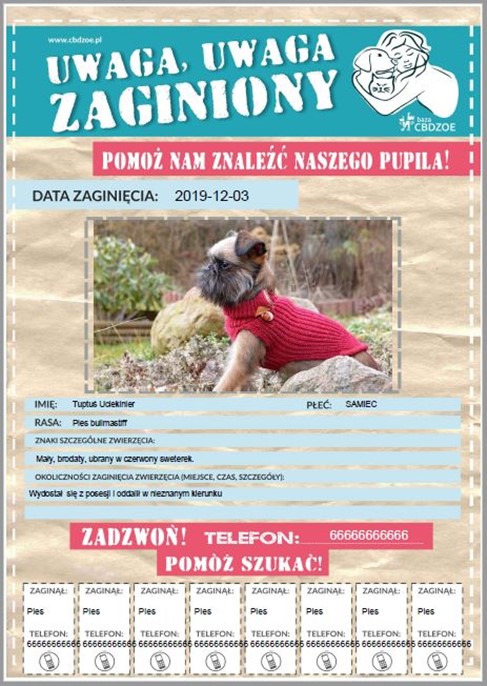The number of registered
animals is growing every day
Published: Feb 4, 2020

Most pet owners do not consider that their companion could go missing, run away or be stolen. They are convinced that nothing will ever happen if they do everything right and always keep an eye on their dog or cat, making sure it never strays too far away or is always on a leash.
However, unexpected situations happen much more frequently that we would like and are a terrible source of stress for both the owner and the animal itself! An unexpected encounter with a hostile dog, a loud noise which your pet reacts to by trying to escape, or a sudden and irresistible interest in a rustle in the bushes – these may happen to even the most disciplined dog. Many things in life are outside our control, even despite our best efforts, which is why we want to help you deal with such situations and offer you advice on what to do to increase your chance of finding your pet.
Nobody ever assumes the worst case scenario, which is why we are often at a loss as to what to do when our pet goes missing – negative emotions become overwhelming and make the search harder. And at a time like that, every minute counts. A scared dog can run very fast – further decreasing the chance of being found. High-traffic streets and motorways are particularly dangerous in such cases, as a dog or cat can be hit by a speeding car.
Panic is a terrible adviser, which is why we have created this manual on how to remain rational and act effectively to find your pet.
...try to stay calm! Take a look around and try to go in the direction which your dog was headed in. If you have someone with you, split up and go in different directions. Do not call out to your pet nervously – a stressed-out and disoriented dog may have trouble recognising your voice, especially if it has gone missing in a forest. If you can remain composed and call out to it with a calm voice, you can of course do so.
It is possible that your dog got stuck in a bush or some other tight place, so keep an eye on the vegetation, ditches and manholes.
...if the animal is marked with a chip or a tattoo, make sure it is registered in a database. If not, register it immediately using your mobile device. Remember that only entering your and your dog's data into a database will enable its identification when it is found or brought to a shelter. To speed up the process, you can use this link. If you are already registered, make sure that your data is accurate and up to date, and that you have uploaded a photo of your pet. Remember – not everybody knows what your dog or its breed looks like, so it will be much easier to use a photo rather than a description!
...contact the designated animal care institution in your area. If you do not know who to turn to, contact your local police department.
...call your local shelters and interim hotels for homeless animals. It is possible that your dog will be brought to such a place. When you contact a shelter, leave a description of your dog, its microchip number and your contact data. You should also inform the staff about its conditions and special needs, if it has any.
...contact your local veterinarians and clinics and ask to keep an eye out for people who come with a pet which matches your description. You should also leave the number of the microchip your pet is implanted with. Keep in mind that purebred dogs are often stolen, and it is possible that the thief will look for a veterinarian in your area.
...make an ad!
Go to the ALERT PET IS LOST section as soon as possible and fill in a missing pet report. Make sure you attach a photo to make it easier for potential finders to identify your dog.
You can download your post in the form of a poster and put it up in your area, on notice boards and in veterinary clinics. Make sure to protect your posters from the being damaged by the elements.
If you have any social media profiles, especially on websites for pet owners, post the details of your situation, and do not forget to attach photographs!

...as dogs which cannot find their way home often come back to the last place where they saw their owner, leave an item which has your scent on it (like a piece of clothing) and something to eat there, and regularly check if your pet has not come back.
... If you were unable to find your pet after several days, regularly check your social media and classified ads websites. It is possible that a dishonest "finder" will try to sell your pet. We know it sounds terrible, but it does happen!
...sometimes, animals come back or are found after several months, so do not give up! Refresh ad pages, post information on your social media profiles and keep an eye out for ads selling animals.
Stay calm, search the area where the dog went missing, and contact local animal control services and animal shelters.
Microchipping and registering in a database, such as WORLDPETNET, allow for quick identification of the dog and contact with the owner if the dog is found.
It is recommended to put up posters with information about the missing dog, post announcements on social media, and inform nearby veterinary clinics about the situation.




Marking animals with a microchip is the most durable, effective and completely safe method of quick and reliable identification. Every transponder (chip) has a unique number which enables instant identification of the animal and its owner, helping them reunite faster. However, it is important to remember that a chip is just a transponder with an encoded number. It is not a tracking device and contains no data about the animal or the owner! Therefore, in order to identify a chipped dog or cat, it is necessary that a microchip be registered in a national marked animal database...
Read moreIn today's world, responsibility for animal care has become not only a priority for their owners but also a societal issue. One of the most important tools in ensuring animal safety is the chip database. It allows for the quick and efficient recovery of lost pets, which is crucial for protecting their health and well-being.
The introduction of microchipping has significantly improved the effectiveness of efforts to locate lost animals, reducing stress for both owners and their four-legged friends. Registration in the chip database is increasingly required by local regulations, further highlighting the importance of this technology in ensuring comprehensive care for animals.